实验3 类和对象_基础编程2
1. 实验任务1
button.hpp源代码:
1 #pragma once 2 3 #include <iostream> 4 #include <string> 5 6 using std::string; 7 using std::cout; 8 9 // 按钮类 10 class Button { 11 public: 12 Button(const string& text); 13 string get_label() const; 14 void click(); 15 16 private: 17 string label; 18 }; 19 20 Button::Button(const string& text) : label{ text } { 21 } 22 23 inline string Button::get_label() const { 24 return label; 25 } 26 27 void Button::click() { 28 cout << "Button '" << label << "' clicked\n"; 29 }
window.hpp源代码:
1 #pragma once 2 #include "button.hpp" 3 #include <vector> 4 #include <iostream> 5 6 using std::vector; 7 using std::cout; 8 using std::endl; 9 10 // 窗口类 11 class Window { 12 public: 13 Window(const string& win_title); 14 void display() const; 15 void close(); 16 void add_button(const string& label); 17 18 private: 19 string title; 20 vector<Button> buttons; 21 }; 22 23 Window::Window(const string& win_title) : title{ win_title } { 24 buttons.push_back(Button("close")); 25 //向buttons容器(这里是一个vector<Button>类型的容器)中添加一个初始按钮,该按钮的标签为 “close” 26 //push_back是vector容器的成员函数,用于在容器末尾添加一个元素 27 } 28 29 inline void Window::display() const { 30 string s(40, '*'); 31 //使用初始化列表的方式来构造这个字符串对象 32 //40表示要创建的字符串的长度为 40,参数'*'表示用字符'*'来填充 33 cout << s << endl; 34 cout << "window title: " << title << endl; 35 cout << "It has " << buttons.size() << " buttons: " << endl; 36 for (const auto& i : buttons) 37 cout << i.get_label() << " button" << endl; 38 cout << s << endl; 39 } 40 41 void Window::close() { 42 cout << "close window '" << title << "'" << endl; 43 buttons.at(0).click();//通过at方法获取容器中的第一个按钮对象 44 } 45 46 void Window::add_button(const string& label) { 47 buttons.push_back(Button(label)); 48 }
task1.cpp源代码:
1 #include "window.hpp" 2 #include <iostream> 3 4 using std::cout; 5 using std::cin; 6 7 void test() { 8 Window w1("new window"); 9 w1.add_button("maximize"); 10 w1.display(); 11 w1.close(); 12 } 13 14 int main() { 15 cout << "用组合类模拟简单GUI:\n"; 16 test(); 17 }
运行截图:
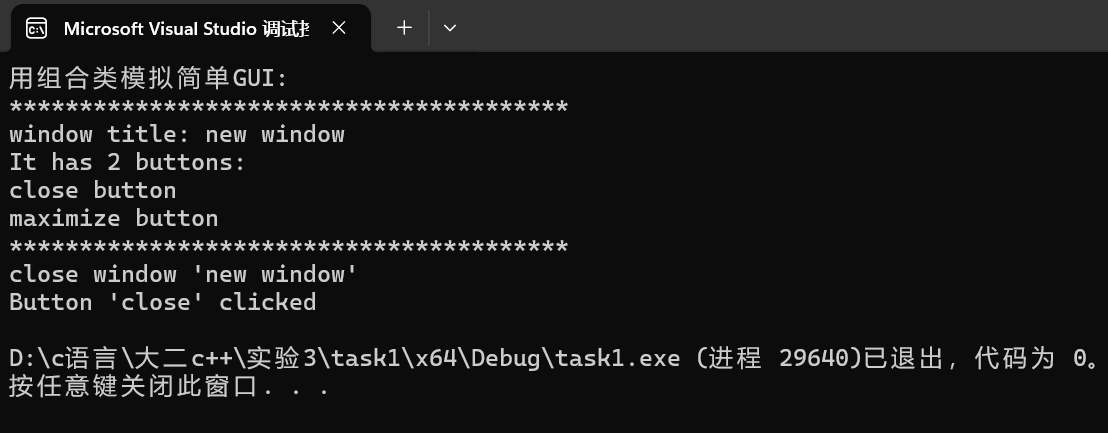 回答问题
回答问题
问题1:这个模拟简单GUI的示例代码中,自定义了几个类?使用到了标准库的哪几个类?哪些类和类之间存在组合关系?
答:自定义了Button类和Window类;使用到了标准库的<iostream><string><vector>;Window类和Button类之间存在组合关系,Window类包含了Button对象,通过在Window类的成员变量中使用vector<Button>来存储按钮。
问题2:在自定义类Button和Window中,有些成员函数定义时加了const, 有些设置成了inline。如果你是类的设计者,目前那些没有加const或没有设置成inline的,适合添加const,适合设置成inline吗?你的思考依据是?
答:
Button类中:
Button(const string& text)为构造函数,构造函数不适合设置为inline,因为构造函数通常会涉及一些复杂的初始化操作,构造函数也不适合添加const,因为构造函数的目的是初始化对象,不是用于提供常量行为。
string get_label() const已经添加了const(表示这个成员函数不会修改类的成员变量)和inline(因为它只是简单地返回一个成员变量)。
void click()适合添加const(此函数不会修改成员变量内容),可以考虑添加inline(因为它的功能相对简单)。
Window类中也同理。
考虑的依据是:函数的复杂性,常量行为,函数的调用频率等。
问题3:类Window的定义中,有string s(40, '*');这样一行代码,其功能是?
答:使用初始化列表的方式来构造这个字符串对象,40表示要创建的字符串的长度为 40,参数'*'表示用字符'*'来填充。
2. 实验任务2
task2.cpp源代码:
1 #include <iostream> 2 #include <vector> 3 4 using namespace std; 5 6 void output1(const vector<int>& v) { 7 for (auto& i : v) 8 cout << i << ", "; 9 cout << "\b\b \n"; 10 } 11 12 void output2(const vector<vector<int>> v) { 13 for (auto& i : v) { 14 for (auto& j : i) 15 cout << j << ", "; 16 cout << "\b\b \n"; 17 } 18 } 19 20 void test1() { 21 vector<int> v1(5, 42); 22 const vector<int> v2(v1); 23 24 v1.at(0) = -999; 25 cout << "v1: "; output1(v1); 26 cout << "v2: "; output1(v2); 27 cout << "v1.at(0) = " << v1.at(0) << endl; 28 cout << "v2.at(0) = " << v2.at(0) << endl; 29 } 30 31 void test2() { 32 vector<vector<int>> v1{ {1, 2, 3}, {4, 5, 6, 7} }; 33 const vector<vector<int>> v2(v1); 34 35 v1.at(0).push_back(-999); 36 cout << "v1: \n"; output2(v1); 37 cout << "v2: \n"; output2(v2); 38 39 vector<int> t1 = v1.at(0); 40 cout << t1.at(t1.size() - 1) << endl; 41 42 const vector<int> t2 = v2.at(0); 43 cout << t2.at(t2.size() - 1) << endl; 44 } 45 46 int main() { 47 cout << "测试1:\n"; 48 test1(); 49 50 cout << "\n测试2:\n"; 51 test2(); 52 }
运行截图:
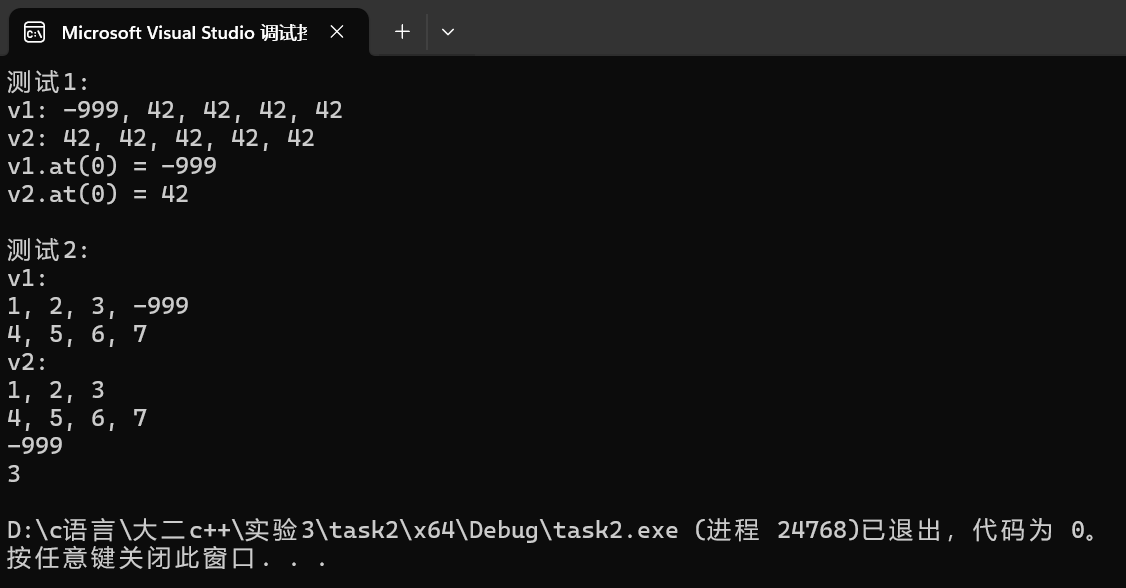
回答问题
问题1:测试1模块中,这三行代码的功能分别是?
答:vector<int> v1(5, 42);声明了一个存储整数的动态数组v1,第一个参数5表示数组的初始大小为 5,第二个参数42表示用值42来初始化这 5 个元素;const vector<int> v2(v1);声明了一个常量的整数向量对象v2,并使用已有的向量v1对v2进行初始化,v2在创建后不能被修改,不能通过v2去修改其存储的整数元素,也不能对v2进行添加、删除元素等会改变其状态的操作。v1.at(0) = -999;将向量v1中索引为 0 (第一个元素)的元素的值修改为 -999。
问题2:测试2模块中,这三行代码的功能分别是?
答:vector<vector<int>> v1{ {1, 2, 3}, {4, 5, 6, 7} };声明了一个存储整数向量的向量对象v1,并使v1包含两个元素,每个元素都是一个整数向量;const vector<vector<int>> v2(v1);声明了一个存储整数向量的向量对象v2,并使用已有的二维向量v1对v2进行初始化;v1.at(0).push_back(-999);在二维向量v1中第一个一维向量的末尾添加一个值为 -999 的元素(首先访问v1中的第一个一维向量,然后调用一维向量的push_back成员函数,将 -999 这个值添加到该一维向量的末尾)。
问题3:测试2模块中,这四行代码的功能分别是?
答:vector<int> t1 = v1.at(0);声明了一个整数向量对象t1,将二维向量v1中索引为 0 的一维向量赋值给t1(即v1中第一个一维向量的所有元素复制到t1中);cout << t1.at(t1.size() - 1) << endl;输出t1向量中最后一个元素的值;const vector<int> t2 = v2.at(0);声明了一个常量的整数向量t2,将二维向量v2中索引为 0 的一维向量赋值给t2;cout << t2.at(t2.size() - 1) << endl;输出常量整数向量t2中最后一个元素的值。
问题4:根据执行结果,反向分析、推断:
① 标准库模板类vector内部封装的复制构造函数,其实现机制是深复制还是浅复制?
② 模板类vector的接口at(), 是否至少需要提供一个const成员函数作为接口?
答:①深复制;②需要,例如当有一个常量的vector对象时,如果没有const版本的at()函数,就无法安全地访问这个常量对象中的元素。
3. 实验任务3
vectorInt.hpp源代码:
1 #pragma once 2 3 #include <iostream> 4 #include <cassert> 5 6 using std::cout; 7 using std::endl; 8 9 // 动态int数组对象类 10 class vectorInt { 11 public: 12 vectorInt(int n); 13 vectorInt(int n, int value); 14 vectorInt(const vectorInt& vi); 15 ~vectorInt(); 16 17 int& at(int index); 18 const int& at(int index) const; 19 20 vectorInt& assign(const vectorInt& v); 21 int get_size() const; 22 23 private: 24 int size; 25 int* ptr; // ptr指向包含size个int的数组 26 }; 27 28 vectorInt::vectorInt(int n) : size{ n }, ptr{ new int[size] } { 29 } 30 31 vectorInt::vectorInt(int n, int value) : size{ n }, ptr{ new int[size] } { 32 for (auto i = 0; i < size; ++i) 33 ptr[i] = value; 34 } 35 36 vectorInt::vectorInt(const vectorInt& vi) : size{ vi.size }, ptr{ new int[size] } { 37 for (auto i = 0; i < size; ++i) 38 ptr[i] = vi.ptr[i]; 39 } 40 41 vectorInt::~vectorInt() { 42 delete[] ptr; 43 } 44 45 const int& vectorInt::at(int index) const { 46 assert(index >= 0 && index < size); 47 //断言语句,其目的是在程序运行时检查给定的索引index是否在有效范围内 48 //index小于 0 或者大于等于size,程序会立即终止,并输出错误信息,帮助开发者快速定位问题。 49 50 return ptr[index]; 51 } 52 53 int& vectorInt::at(int index) { 54 assert(index >= 0 && index < size); 55 56 return ptr[index]; 57 } 58 59 vectorInt& vectorInt::assign(const vectorInt& v) { 60 delete[] ptr; // 释放对象中ptr原来指向的资源 61 62 size = v.size; 63 ptr = new int[size]; 64 65 for (int i = 0; i < size; ++i) 66 ptr[i] = v.ptr[i]; 67 68 return *this; 69 } 70 71 int vectorInt::get_size() const { 72 return size; 73 }
task3.cpp源代码:
1 #include "vectorInt.hpp" 2 #include <iostream> 3 4 using std::cin; 5 using std::cout; 6 7 void output(const vectorInt& vi) { 8 for (auto i = 0; i < vi.get_size(); ++i) 9 cout << vi.at(i) << ", "; 10 cout << "\b\b \n"; 11 } 12 13 14 void test1() { 15 int n; 16 cout << "Enter n: "; 17 cin >> n; 18 19 vectorInt x1(n); 20 for (auto i = 0; i < n; ++i) 21 x1.at(i) = i * i; 22 cout << "x1: "; output(x1); 23 24 vectorInt x2(n, 42); 25 vectorInt x3(x2); 26 x2.at(0) = -999; 27 cout << "x2: "; output(x2); 28 cout << "x3: "; output(x3); 29 } 30 31 void test2() { 32 const vectorInt x(5, 42); 33 vectorInt y(10, 0); 34 35 cout << "y: "; output(y); 36 y.assign(x); 37 cout << "y: "; output(y); 38 39 cout << "x.at(0) = " << x.at(0) << endl; 40 cout << "y.at(0) = " << y.at(0) << endl; 41 } 42 43 int main() { 44 cout << "测试1: \n"; 45 test1(); 46 47 cout << "\n测试2: \n"; 48 test2(); 49 }
运行截图:
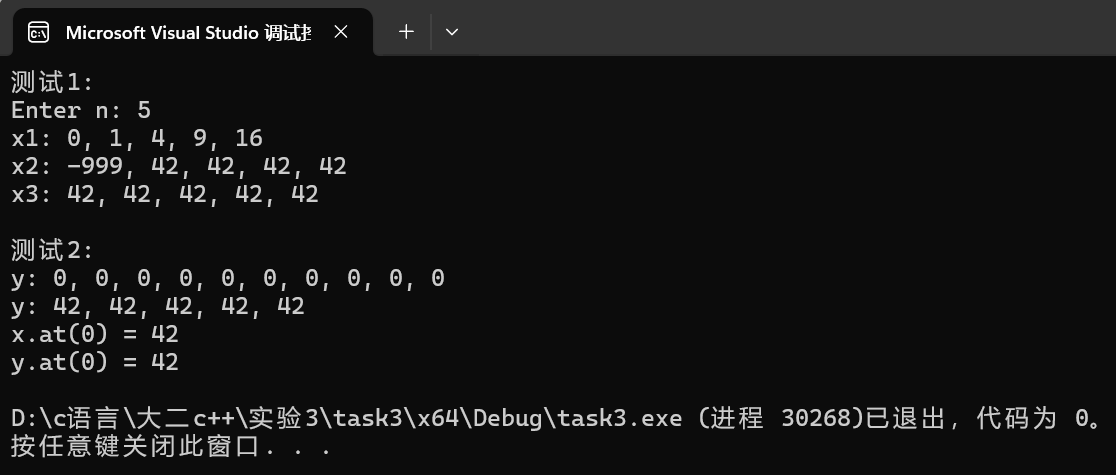
问题1:vectorInt类中,复制构造函数(line14)的实现,是深复制还是浅复制?
答:深复制,因为新创建的对象和源对象拥有独立的内存空间。
问题2:vectorInt类中,这两个at()接口,如果返回值类型改成int而非int&(相应地,实现部分也同步修改),测试代码还能正确运行吗?如果把line18返回值类型前面的const去掉,针对这个测试代码,是否有潜在安全隐患?尝试分析说明。
答:①int& at(int index);中返回值类型改成int将不能正确运行;const int& at(int index) const;中返回值类型改成int将可以正确运行;这是因为当返回值为int时,函数返回的是一个值的副本而不是引用,这意味着不能通过返回值来修改对象中的元素。如果测试代码中只是读取元素的值,那么不会有问题。但如果测试代码中有尝试通过返回值修改元素的操作,那么这些操作将不再生效。②把line18返回值类型前面的const去掉,针对测试代码并没有潜在安全隐患,因为测试代码中只是读取了元素的值,并没有尝试修改它。
问题3:vectorInt类中,assign()接口,返回值类型可以改成vectorInt吗?你的结论及原因分析。
答:可以。改成vectorInt意味着每次调用assign都会创建一个新的对象并返回它,这只会带来额外的性能开销,对于测试代码的实现并不会有其他影响。
4. 实验任务4
Matrix.hpp源代码:
1 #pragma once 2 3 #include <iostream> 4 #include <cassert> 5 6 using std::cout; 7 using std::endl; 8 9 // 类Matrix的声明 10 class Matrix { 11 public: 12 Matrix(int n, int m); // 构造函数,构造一个n*m的矩阵, 初始值为value 13 Matrix(int n); // 构造函数,构造一个n*n的矩阵, 初始值为value 14 Matrix(const Matrix& x); // 复制构造函数, 使用已有的矩阵X构造 15 ~Matrix(); 16 17 void set(const double* pvalue); // 用pvalue指向的连续内存块数据按行为矩阵赋值 18 void clear(); // 把矩阵对象的值置0 19 20 const double& at(int i, int j) const; // 返回矩阵对象索引(i,j)的元素const引用 21 double& at(int i, int j); // 返回矩阵对象索引(i,j)的元素引用 22 23 int get_lines() const; // 返回矩阵对象行数 24 int get_cols() const; // 返回矩阵对象列数 25 26 void display() const; // 按行显示矩阵对象元素值 27 28 private: 29 int lines; // 矩阵对象内元素行数 30 int cols; // 矩阵对象内元素列数 31 double* ptr; 32 }; 33 34 // 类Matrix的实现:待补足 35 Matrix::Matrix(int n, int m) :lines{ n }, cols{ m }, ptr{ new double[n * m] }{ 36 clear(); 37 } 38 39 Matrix::Matrix(int n):Matrix(n, n) { 40 //Matrix::Matrix(n, n); 41 } 42 /* 43 Matrix::Matrix(int n):Matrix(n, n) { } 44 //使用了委托构造函数,先调用Matrix(int n, int m)构造函数来构造对象 45 Matrix::Matrix(int n) { Matrix(n, n); } 46 //这里的Matrix(n, n)会创建一个新的临时Matrix对象,但这个临时对象在创建后就被丢弃了,并不会用来初始化当前正在构造的对象。当前对象的成员变量没有被正确初始化,仍然处于未定义的状态。 47 */ 48 Matrix::Matrix(const Matrix& x) :lines{ x.lines }, cols{ x.cols }, ptr{ new double[lines * cols] } { 49 for (auto i = 0; i < lines * cols; i++) 50 ptr[i] = x.ptr[i];//当成一维数组 51 } 52 53 Matrix::~Matrix() { 54 delete[] ptr;//delete和delete[]的使用场景不同:delete用于释放单个对象的内存;delete[]用于释放动态分配的数组内存。 55 } 56 57 void Matrix::set(const double* pvalue) { 58 for (auto i = 0; i < lines * cols; i++) 59 ptr[i] = pvalue[i]; 60 } 61 62 void Matrix::clear() { 63 for (auto i = 0; i < lines * cols; i++) 64 ptr[i] = 0; 65 } 66 67 const double& Matrix::at(int i, int j) const { 68 return ptr[i * cols + j]; 69 } 70 71 double& Matrix::at(int i, int j) { 72 return ptr[i * cols + j]; 73 } 74 75 int Matrix::get_lines() const { 76 return lines; 77 } 78 79 int Matrix::get_cols() const { 80 return cols; 81 } 82 83 void Matrix::display() const { 84 for (auto i = 0; i < lines; i++) { 85 for (auto j = 0; j < cols; j++) { 86 cout << ptr[i * cols + j] << ","; 87 } 88 cout << "\b \n";//“\b”是转义字符,表示退格 89 } 90 }
task4.cpp源代码:
1 #include "matrix.hpp" 2 #include <iostream> 3 #include <cassert> 4 5 using std::cin; 6 using std::cout; 7 using std::endl; 8 9 10 const int N = 1000; 11 12 // 输出矩阵对象索引为index所在行的所有元素 13 void output(const Matrix& m, int index) { 14 assert(index >= 0 && index < m.get_lines()); 15 16 for (auto j = 0; j < m.get_cols(); ++j) 17 cout << m.at(index, j) << ", "; 18 cout << "\b\b \n"; 19 } 20 21 22 void test1() { 23 double x[1000] = { 1, 2, 3, 4, 5, 6, 7, 8, 9 }; 24 25 int n, m; 26 cout << "Enter n and m: "; 27 cin >> n >> m; 28 29 Matrix m1(n, m); // 创建矩阵对象m1, 大小n×m 30 m1.set(x); // 用一维数组x的值按行为矩阵m1赋值 31 32 Matrix m2(m, n); // 创建矩阵对象m1, 大小m×n 33 m2.set(x); // 用一维数组x的值按行为矩阵m2赋值 34 35 Matrix m3(2); // 创建一个2×2矩阵对象 36 m3.set(x); // 用一维数组x的值按行为矩阵m3赋值 37 38 cout << "矩阵对象m1: \n"; m1.display(); cout << endl; 39 cout << "矩阵对象m2: \n"; m2.display(); cout << endl; 40 cout << "矩阵对象m3: \n"; m3.display(); cout << endl; 41 } 42 43 void test2() { 44 Matrix m1(2, 3); 45 m1.clear(); 46 47 const Matrix m2(m1); 48 m1.at(0, 0) = -999; 49 50 cout << "m1.at(0, 0) = " << m1.at(0, 0) << endl; 51 cout << "m2.at(0, 0) = " << m2.at(0, 0) << endl; 52 cout << "矩阵对象m1第0行: "; output(m1, 0); 53 cout << "矩阵对象m2第0行: "; output(m2, 0); 54 } 55 56 int main() { 57 cout << "测试1: \n"; 58 test1(); 59 60 cout << "测试2: \n"; 61 test2(); 62 }
运行截图:
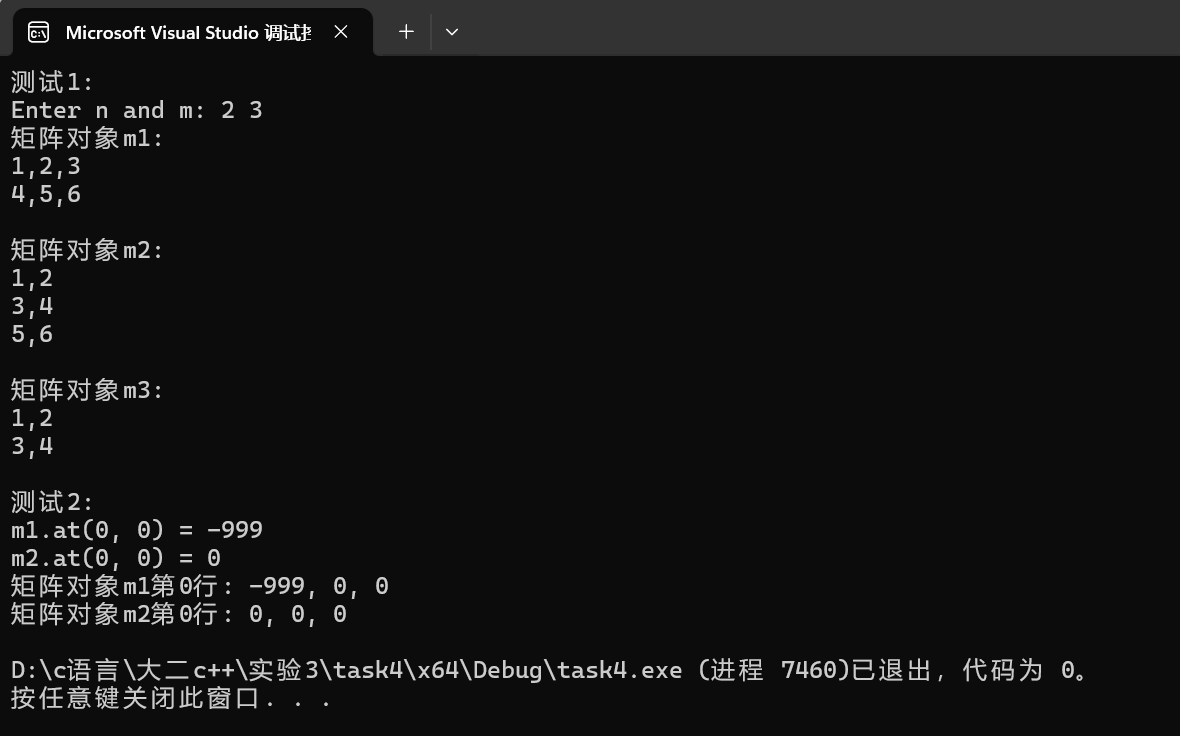
task4.cpp中数组x换一组测试数据double x[1000] = { 8,8,8,8 };的运行截图:
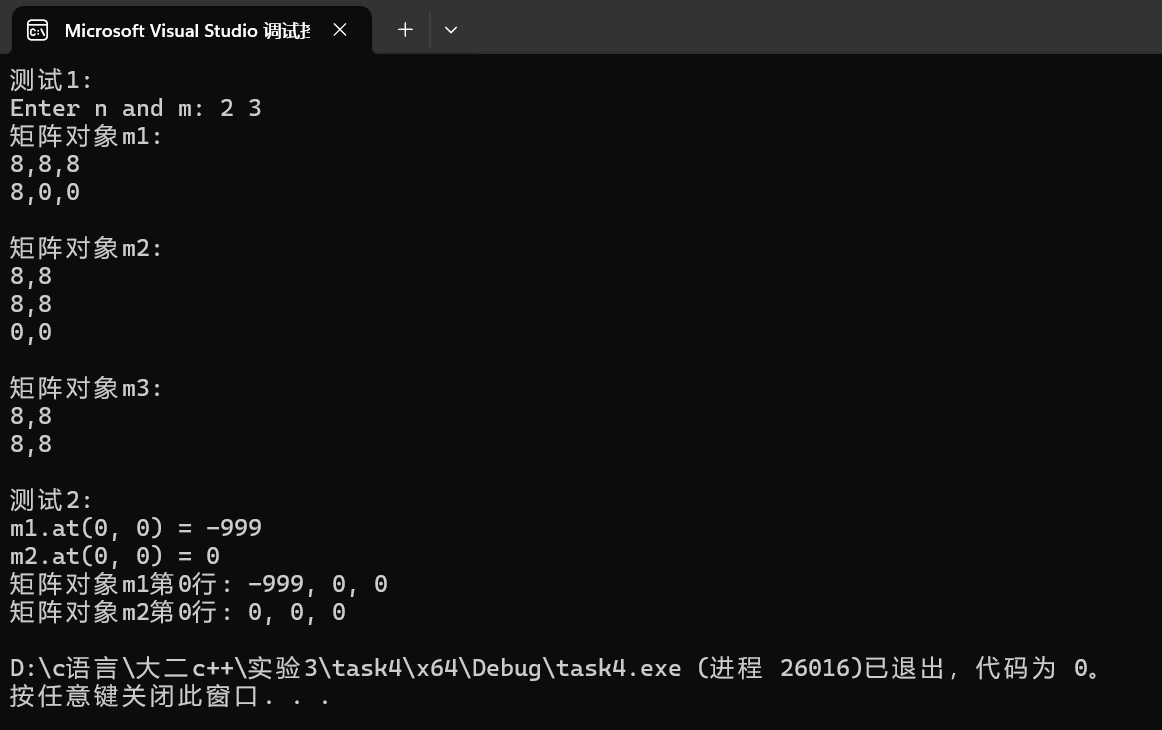
5. 实验任务5
User.hpp源代码:
#pragma once
#include <iostream>
#include <string>
class User {
public:
User(std::string name, std::string password, std::string email);
void set_email();
void change_password();
void display();
private:
std::string name, password, email;
};
User::User(std::string name, std::string password = "123456", std::string email = ""):name{name}, password{password}, email{email}{}
void User::set_email() {
std::string eamil_temp;
std::cout << "Please Enter Your Email Address:";
std::cin >> eamil_temp;
do {
if (eamil_temp.find('@') == std::string::npos) {
std::cout << "Wrong Address!Reenter:";
std::cin >> eamil_temp;
}
} while (eamil_temp.find('@') == std::string::npos);
email = eamil_temp;
std::cout << "Set Email Successfully!" << std::endl;
}
void User::change_password() {
int attempts = 0;
while (attempts < 3) {
std::string inputPassword;
std::cout << "Enter Old Password:";
std::cin >> inputPassword;
if (inputPassword == password) {
std::string newPassword;
std::cout << "Enter New Password:";
std::cin >> newPassword;
password = newPassword;
std::cout << "Change Password Successfully!" << std::endl;
break;
}
else if (attempts != 2) {
std::cout << "The Old Password is Wrong,You Have " << 3 - ++attempts << " More Chances。" << std::endl;
}
else if (attempts == 2) {
std::cout << "Three Errors!Try Again Later~~~" << std::endl;
//以下冻结程序代码来源于资料查找后修改所得
int coolingTime = 180;//定义一个整数变量coolingTime并初始化为180s
time_t startTime = time(nullptr);//获取当前时间作为冷却时间的起始时间点
//time_t是一种用于表示时间的类型,time(nullptr)函数返回当前的日历时间。
time_t currentTime;
while ((currentTime = time(nullptr)) - startTime < coolingTime) {
int remainingTime = coolingTime - (currentTime - startTime);
std::cout << "剩余冷却时间:" << remainingTime << " 秒。\r";
//输出剩余冷却时间
//使用\r将光标移回到当前行的开头,以便在下次输出时覆盖上一次的显示内容,实现动态更新的效果
std::cout.flush();//刷新输出缓冲区,确保输出立即显示在控制台,而不是被缓冲等待更多的输出内容后再一起显示
}
attempts = 0;
}
}
}
void User::display() {
std::cout << "name:" << name << std::endl;
std::cout << "pass:" << std::string(password.length(), '*') << std::endl;
std::cout << "email:" << email << std::endl;
}task5.hpp源代码:
1 #include "user.hpp" 2 #include <iostream> 3 #include <vector> 4 #include <string> 5 6 using std::cin; 7 using std::cout; 8 using std::endl; 9 using std::vector; 10 using std::string; 11 12 void test() { 13 vector<User> user_lst; 14 15 User u1("Alice", "2024113", "Alice@hotmail.com"); 16 user_lst.push_back(u1); 17 18 User u2("Bob"); 19 u2.set_email(); 20 u2.change_password(); 21 user_lst.push_back(u2); 22 cout << endl; 23 24 User u3("Hellen"); 25 u3.set_email(); 26 u3.change_password(); 27 user_lst.push_back(u3); 28 cout << endl; 29 30 cout << "There are " << user_lst.size() << " users. they are: " << endl; 31 for (auto& i : user_lst) { 32 i.display(); 33 cout << endl; 34 } 35 } 36 37 int main() { 38 test(); 39 }
运行截图:(后2张为旧密码输错3次,系统冷却180s并动态显示的图片)
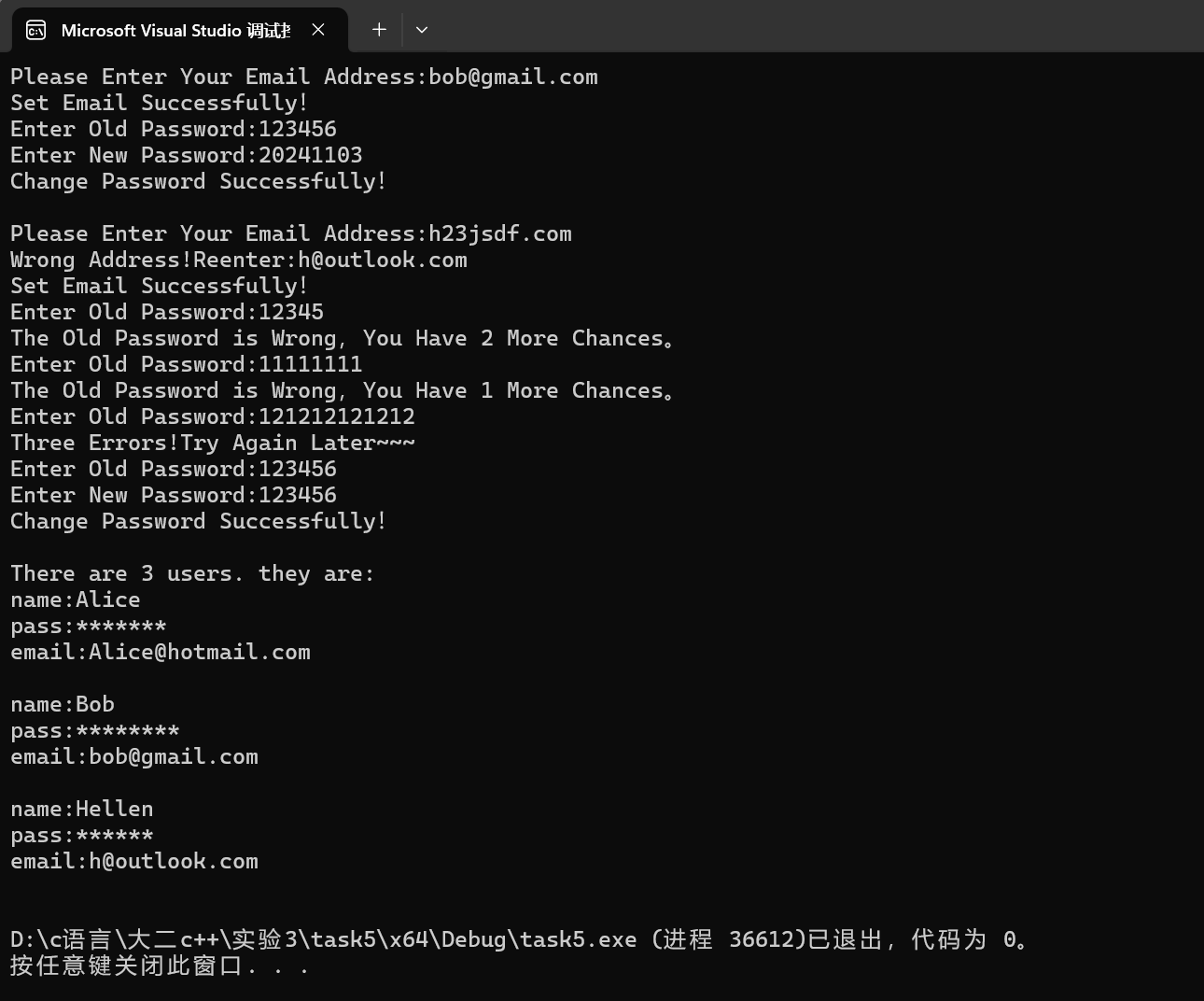
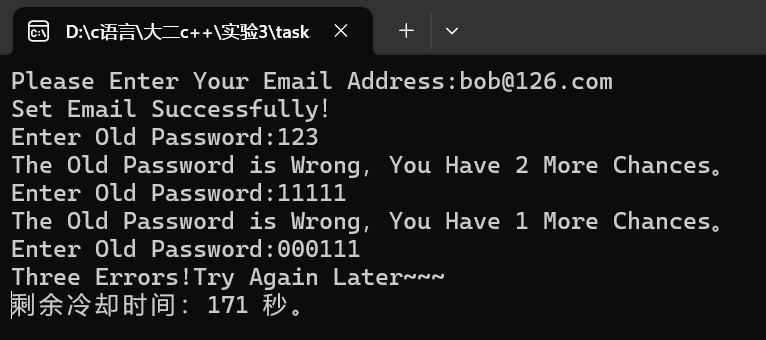
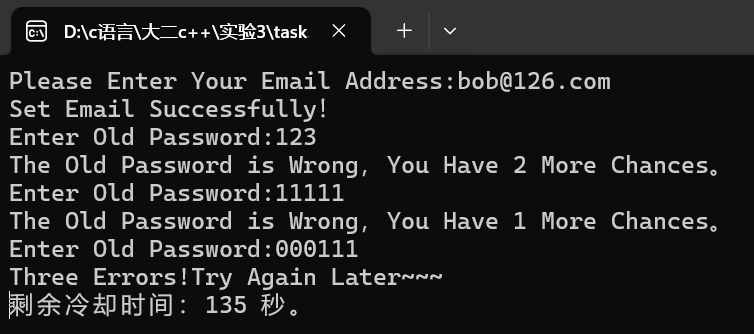
6. 实验任务6
date.h源代码:
#ifndef __DATE_H__
#define __DATE_H__
class Date {
private:
int year;
int month;
int day;
int totalDays;
public:
Date(int year, int month, int day);
int getYear() const { return year; }
int getMonth() const { return month; }
int getDay() const { return day; }
int getMaxDay() const;
bool isLeapYear() const {
return year % 4 == 0 && year % 100 != 0 || year % 400 == 0;
}
void show() const;
int distance(const Date& date) const {
return totalDays - date.totalDays;
}
};
#endif //__DATE_H__date.cpp源代码:
#include "date.h"
#include <iostream>
#include <cstdlib>
using namespace std;
namespace {
const int DAYS_BEFORE_MONTH[] = { 0, 31, 59, 90, 120, 151, 181, 212, 243, 273, 304, 334, 365 };
}
Date::Date(int year, int month, int day) : year(year), month(month), day(day) {
if (day <= 0 || day > getMaxDay()) {
cout << "Invalid date: ";
show();
cout << endl;
exit(1);
}
int years = year - 1;
totalDays = years * 365 + years / 4 - years / 100 + years / 400
+ DAYS_BEFORE_MONTH[month - 1] + day;
if (isLeapYear() && month > 2) totalDays++;
}
int Date::getMaxDay() const {
if (isLeapYear() && month == 2)
return 29;
else
return DAYS_BEFORE_MONTH[month] - DAYS_BEFORE_MONTH[month - 1];
}
void Date::show() const {
cout << getYear() << "-" << getMonth() << "-" << getDay();
}account.h源代码:
#ifndef __ACCOUNT_H__
#define __ACCOUNT_H__
#include "date.h"
#include <string>
class SavingsAccount {
private:
std::string id;
double balance;
double rate;
Date lastDate;
double accumulation;
static double total;
void record(const Date& date, double amount, const std::string& desc);
void error(const std::string& msg) const;
double accumulate(const Date& date) const {
return accumulation + balance * date.distance(lastDate);
}
public:
SavingsAccount(const Date& date, const std::string& id, double rate);
const std::string& getId() const { return id; }
double getBalance() const { return balance; }
double getRate() const { return rate; }
static double getTotal() { return total; }
void deposit(const Date& date, double amount, const std::string& desc);
void withdraw(const Date& date, double amount, const std::string& desc);
void settle(const Date& date);
void show() const;
};
#endif //__ACCOUNT_H__account.cpp源代码:
#include "account.h"
#include <cmath>
#include <iostream>
using namespace std;
double SavingsAccount::total = 0;
SavingsAccount::SavingsAccount(const Date& date, const string& id, double rate)
: id(id), balance(0), rate(rate), lastDate(date), accumulation(0) {
date.show();
cout << "\t#" << id << " created" << endl;
}
void SavingsAccount::record(const Date& date, double amount, const string& desc) {
accumulation = accumulate(date);
lastDate = date;
amount = floor(amount * 100 + 0.5) / 100;
balance += amount;
total += amount;
date.show();
cout << "\t#" << id << "\t" << amount << "\t" << balance << "\t" << desc << endl;
}
void SavingsAccount::error(const string& msg) const {
cout << "Error(#" << id << "): " << msg << endl;
}
void SavingsAccount::deposit(const Date& date, double amount, const string& desc) {
record(date, amount, desc);
}
void SavingsAccount::withdraw(const Date& date, double amount, const string& desc) {
if (amount > getBalance())
error("not enough money");
else
record(date, -amount, desc);
}
void SavingsAccount::settle(const Date& date) {
double interest = accumulate(date) * rate / date.distance(Date(date.getYear() - 1, 1, 1));
if (interest != 0)
record(date, interest, "interest");
accumulation = 0;
}
void SavingsAccount::show() const {
cout << id << "\tBalance: " << balance;
}6_25.cpp源代码:
#include "account.h"
#include <iostream>
using namespace std;
int main() {
Date date(2008, 11, 1);
SavingsAccount accounts[] = {
SavingsAccount(date, "03755217", 0.015),
SavingsAccount(date, "02342342", 0.015)
};
const int n = sizeof(accounts) / sizeof(SavingsAccount);
accounts[0].deposit(Date(2008, 11, 5), 5000, "salary");
accounts[1].deposit(Date(2008, 11, 25), 10000, "sell stock 0323");
accounts[0].deposit(Date(2008, 12, 5), 5500, "salary");
accounts[1].withdraw(Date(2008, 12, 20), 4000, "buy a laptop");
cout << endl;
for (int i = 0; i < n; i++) {
accounts[i].settle(Date(2009, 1, 1));
accounts[i].show();
cout << endl;
}
cout << "Total: " << SavingsAccount::getTotal() << endl;
return 0;
}运行截图:
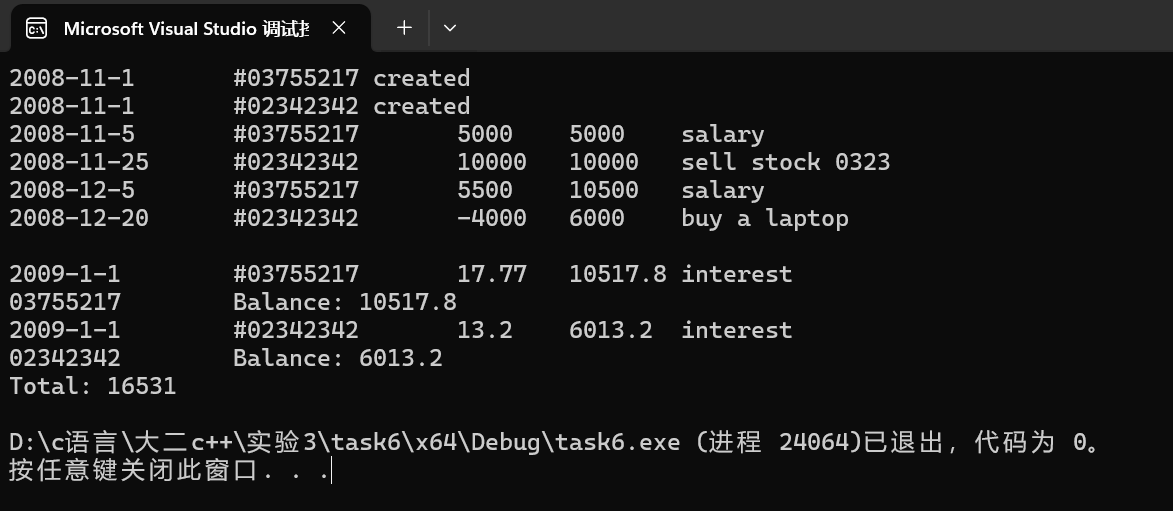
[实验总结]
1、push_back是vector容器的成员函数,用于在容器末尾添加一个元素。
2、使用初始化列表的方式构造字符串对象:eg.string s(40, '*');40表示要创建的字符串的长度为 40,参数'*'表示用字符'*'来填充。
3、assert函数:eg.assert(index >= 0 && index < size);断言语句,其目的是在程序运行时检查给定的索引index是否在有效范围内。若index小于 0 或者大于等于size,程序会立即终止,并输出错误信息,帮助开发者快速定位问题。
4、Matrix::Matrix(int n):Matrix(n, n) { }使用了委托构造函数,先调用Matrix(int n, int m)构造函数来构造对象
Matrix::Matrix(int n) { Matrix(n, n); }这里的Matrix(n, n)会创建一个新的临时Matrix对象,但这个临时对象在创建后就被丢弃了,并不会用来初始化当前正在构造的对象。当前对象的成员变量没有被正确初始化,仍然处于未定义的状态。
5、delete和delete[]的使用场景不同:delete用于释放单个对象的内存;delete[]用于释放动态分配的数组内存。
6、转义字符\b:表示退格,在输出流中使用 “\b” 时,它会使输出位置后退一格,可用于覆盖前面的输出内容。
7、冻结程序:
int coolingTime = 180;//定义一个整数变量coolingTime并初始化为180s
time_t startTime = time(nullptr);//获取当前时间作为冷却时间的起始时间点
//time_t是一种用于表示时间的类型,time(nullptr)函数返回当前的日历时间。
time_t currentTime;
while ((currentTime = time(nullptr)) - startTime < coolingTime) {
int remainingTime = coolingTime - (currentTime - startTime);
std::cout << "剩余冷却时间:" << remainingTime << " 秒。\r";
//输出剩余冷却时间
//使用\r将光标移回到当前行的开头,以便在下次输出时覆盖上一次的显示内容,实现动态更新的效果
std::cout.flush();//刷新输出缓冲区,确保输出立即显示在控制台,而不是被缓冲等待更多的输出内容后再一起显示
}8、时间: time_t是一种用于表示时间的类型,time(nullptr)函数返回当前的日历时间。
9、转义字符\r:将光标移回到当前行的开头,以便在下次输出时覆盖上一次的显示内容。
10、std::cout.flush();刷新输出缓冲区,确保输出立即显示在控制台,而不是被缓冲等待更多的输出内容后再一起显示。
心得:本次实验学到了很多十分有趣的操作,包括使用转义字符控制输出、冻结程序、刷新缓冲区等很新的概念,十分有趣!同时,也见识到了委托构造、初始化列表构造的“威力”与易错点。通过额外的学习发现了相似函数的区别,如delete和delete[]。不过实验6从书本上敲出代码还是好累😣,但是过程也帮助理解了许多程序的用意,只是在看完全部代码后,很难再将其改进,感觉书上的已经很完善,有些其他点子自己也很难实现,还是要继续积累、学习!💯




【推荐】国内首个AI IDE,深度理解中文开发场景,立即下载体验Trae
【推荐】编程新体验,更懂你的AI,立即体验豆包MarsCode编程助手
【推荐】抖音旗下AI助手豆包,你的智能百科全书,全免费不限次数
【推荐】轻量又高性能的 SSH 工具 IShell:AI 加持,快人一步
· 10年+ .NET Coder 心语 ── 封装的思维:从隐藏、稳定开始理解其本质意义
· 地球OL攻略 —— 某应届生求职总结
· 提示词工程——AI应用必不可少的技术
· Open-Sora 2.0 重磅开源!
· 周边上新:园子的第一款马克杯温暖上架